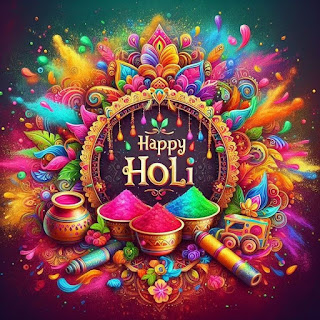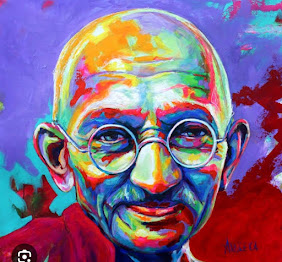The India big festival of Holi இந்தியாவில் ஹோலி பண்டிகை, வண்ணங்களின் திருவிழாவாகும், வசந்த காலத்தை பொடியால் கொண்டாடுகிறது
The Holi Festival
The Holi Festival, also known as the Festival of Colors, is one of the most vibrant and widely celebrated festivals in India. It marks the arrival of spring and the triumph of good over evil. It is celebrated with joy, enthusiasm, and much fanfare, both in India and across the globe. Holi is a time for friends, family, and communities to come together, dance, sing, and throw colorful powders at each other. It is a time when social boundaries fade away, and everyone is united in the celebration of life.
Origins and Significance of Holi
The origins of Holi can be traced back to various ancient legends, one of the most famous being the story of Prahlad and Holika from Hindu mythology. Prahlad, a devout follower of Lord Vishnu, was the son of the demon king Hiranyakashipu, who was opposed to the worship of Vishnu. Despite his father's strict orders, Prahlad continued to worship Vishnu, which angered Hiranyakashipu. He made several attempts to kill Prahlad, but all failed.
In one of the most famous episodes, Hiranyakashipu asked his sister Holika, who had a magical cloak that made her immune to fire, to sit with Prahlad in a fire. However, as the fire blazed, Holika’s cloak flew off and attached itself to Prahlad, saving him while Holika was burned to death. This event is celebrated as the triumph of good over evil, symbolized by the Holi festival. The night before the main day of Holi, people light bonfires to commemorate the burning of Holika, a tradition known as Holika Dahan.
Another popular mythological story associated with Holi is the tale of Radha and Krishna. The playful relationship between Lord Krishna and Radha is a central theme of Holi celebrations, especially in the Braj region of India. According to the myth, Krishna, who was dark-skinned, was concerned that Radha, who was fair-skinned, might not like him because of their skin color. To overcome this, Krishna playfully smeared Radha’s face with color, and this act became a symbol of the carefree and joyous celebration of Holi.
The Celebration of Holi
Holi is celebrated on the full moon day of Phalguna (usually in March), marking the end of winter and the beginning of the harvest season. The festival is spread across two days: Choti Holi or Holika Dahan, and Rangwali Holi or the main day of playing with colors.
1. Holika Dahan (The Bonfire Night):
The first day of Holi is marked by the Holika Dahan ritual. Large bonfires are lit in communities, symbolizing the burning away of evil and the victory of good. People gather around the fire, sing traditional songs, and offer prayers to ward off negativity and bad luck. This ritual also signifies the victory of devotion and purity over wickedness, as seen in the story of Prahlad and Holika.
2. Rangwali Holi (The Festival of Colors):
The second day of Holi is the most exciting and visually spectacular. People throw vibrant powders, or gulal, at each other in a joyous celebration of color and life. The streets, temples, and homes are filled with hues of red, pink, yellow, green, and blue, as men and women of all ages engage in playful color fights. The use of water balloons and colored water-filled pichkaris (water guns) adds to the fun.
Music and dance play a huge part in the celebration. Traditional folk songs, especially Holi geet (Holi songs), are sung by people while dancing around in a circle. In some regions, people perform dholak (drum) beats, and bhangra or garba (traditional dances) add to the festive atmosphere. The streets turn into a vibrant and chaotic scene, with people forgetting their age, social status, and past differences, and simply celebrating the joy of life.
Regional Variations
Holi is celebrated differently across various regions of India and even abroad. Some regions have unique traditions and practices that make their Holi celebrations distinct.
Vrindavan and Mathura:
In the Braj region, where Lord Krishna spent his childhood, Holi is celebrated in a very traditional and grand way. The celebrations here are known for their Lathmar Holi, where men and women playfully hit each other with sticks. The streets of Vrindavan and Mathura become a riot of color, with elaborate processions, temple rituals, and special performances.
Barsana:
The town of Barsana, near Mathura, is famous for its Lathmar Holi. According to local legends, women from Barsana used to chase men from Nandgaon (where Krishna lived) with sticks as they attempted to play Holi. The tradition continues today, with men daringly approaching women in Barsana to be playfully beaten.
Shahkot, Punjab:
In Punjab, Holi is celebrated with a unique twist. It is a two-day event that begins with a religious procession, followed by a grand feast. There are also traditions of singing Holi songs and playing with colors. The festivities are more family-centric, with people exchanging sweets and gifts.
Goa:
In Goa, the festival is celebrated with water-filled balloons, music, and a relaxed atmosphere. People move in groups, with some playing traditional games like Rangpanchami. The celebrations are often accompanied by Goan folk music and dance.
Nepal:
Holi is also widely celebrated in Nepal, especially by the Madhesi community. It is similar to the celebration in India but also involves people visiting family members and friends, where they apply color to each other's faces and exchange sweets.
Symbolism of Holi
Holi holds deep symbolism in both religious and cultural contexts:
1. Victory of Good Over Evil:
Holi commemorates the defeat of evil forces, as seen in the myth of Prahlad and Holika. The bonfires symbolize the destruction of negativity and the triumph of virtue.
2. Rebirth and Renewal:
The festival marks the end of winter and the arrival of spring, symbolizing the renewal of life and nature. It is a time when people clean their homes, renew relationships, and start afresh.
3. Social Harmony:
Holi is a time when social and economic divisions disappear. It is one of the few occasions when people from different backgrounds, irrespective of caste, class, or creed, come together to celebrate. The act of throwing colors signifies the breaking down of social barriers, and everyone participates equally in the revelry.
4. Color as Expression:
The colors used during Holi represent the diversity of life. Each color holds a specific meaning—red symbolizes love, yellow represents knowledge, green symbolizes prosperity, and blue stands for calmness. The playful act of splashing color symbolizes a cheerful outlook on life.
Modern-Day Holi Celebrations
In the modern world, Holi has gained international popularity, especially in countries with large Indian communities, such as the United States, the United Kingdom, Canada, and Australia. In these countries, Holi is celebrated not only by people of Indian origin but also by people of various cultural backgrounds. Holi parties are organized in parks, clubs, and even universities, where people come together to throw colors, dance to Bollywood music, and celebrate the spirit of the festival.
In urban areas, people often celebrate Holi in a more controlled environment. Instead of using dry colors, people use organic and safe colors that are gentle on the skin and hair. Many companies and organizations hold Holi events for their employees to foster team spirit. The rise of social media has also made Holi a global phenomenon, with people sharing pictures and videos of their celebrations, thus spreading the joy of the festival to a global audience.
Environmental and Health Concerns
While Holi is a fun and exciting festival, it also raises some concerns regarding the environmental and health impacts of the celebrations. The use of chemical-based colors can cause skin irritation and harm the environment. The excessive use of water in the celebrations can also lead to wastage, which is a significant concern in drought-prone areas.
In recent years, there has been a growing awareness of these issues, and many people are opting for eco-friendly Holi celebrations. The use of natural colors made from flowers, fruits, and herbs has gained popularity. Additionally, many people are taking steps to minimize water usage and avoid harmful chemicals in the colors.
Conclusion
The Holi Festival is a timeless celebration of life, love, and joy. Rooted in mythology and cultural traditions, it brings people together to celebrate the arrival of spring and the victory of good over evil. Whether celebrated in the streets of India, in foreign lands, or in private homes, Holi is an occasion that transcends boundaries and reminds people of the importance of unity, renewal, and happiness. Through its colors, music, and shared experiences, Holi continues to be a celebration that tou
ches the hearts of millions, bringing color to the world in more ways than one.
"This Content Sponsored by Buymote Shopping app
BuyMote E-Shopping Application is One of the Online Shopping App
Now Available on Play Store & App Store (Buymote E-Shopping)
Click Below Link and Install Application: https://buymote.shop/links/0f5993744a9213079a6b53e8
Sponsor Content: #buymote #buymoteeshopping #buymoteonline #buymoteshopping #buymoteapplication"




Comments
Post a Comment